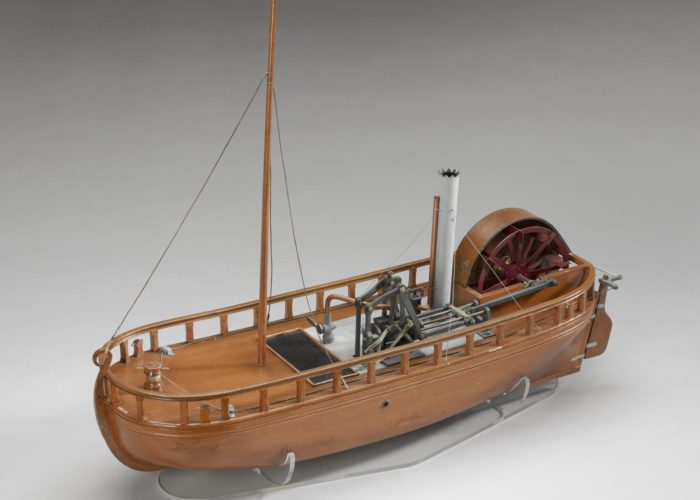Forth and Clyde Canal steamboat: Charlotte Dundas
Theme: Transporting revolution, Economic and technological revolution
Britain’s canal system was a relatively short lived, but nevertheless important revolution in transport. Canals were an essential part of the Industrial Revolution and spawned Britain’s first successful steamboat, the Charlotte Dundas.
Britain’s canals as we know them today came about as a direct result of the need to transport materials and goods as quickly and cheaply as possible around the country, especially bulky goods such as coal which were critical to Britain’s growing manufacturing industries. Pulled by just one horse, a canal boat could transport 30 tons, compared to just 1 ton that could be carried by a horse and cart on Britain’s uneven roads.
The Forth and Clyde canal opened in 1790 and stretched across Scotland from the Firth of Forth to the Firth of Clyde. Not only did it provide an essential route for the transport of both goods and people, it also allowed smaller seagoing vessels passage between east and west without having to go around the north coast of Scotland. Around this time, Lord Thomas Dundas, the Governor of the Canal, became aware of attempts to build boats powered by steam. In particular the work of a Scottish engineer William Symington who had developed a steam engine that could turn a paddle wheel, mounted in a boat. Recognising the potential of steamboats to improve transport on his canal, Dundas supported Symington in refining his design. The result was the steamboat the Charlotte Dundas, built in 1803 and named after Lord Dundas’ daughter.
After successful trials the steamboat proved its potential, towing two 70-ton barges some 20 miles against a head wind that had stopped the boats pulled by horses. Sadly, concerns that the boat would damage the canal’s banks meant his design was never fully put to use. But the Charlotte Dundas had proved the practicality of steam-powered boats and laid the groundwork for a revolution in steam-powered transport that would lead to the iconic Mississippi riverboats and majestic ocean-going steamships like Brunel’s famous SS Great Britain.
In the mid 1800s, the railways began to supersede canals as an even more efficient way of transporting goods and people around the country. But not before over 4,000 miles of canals had been built across the length and breadth of Britain, elegantly servicing Britain’s Industrial Revolution. They are still a key feature of the landscape, a popular site for leisure and recreation and home to whole communities living on brightly painted narrowboats.
Did you know..?
The United States embarked on a canal revolution in the wake of Britain, and in 1821 the Erie Canal linking the Atlantic Ocean (through New York) and the Great Lakes was opened: 363 miles long, 40 feet deep, 4 feet wide, and constructed entirely by hand labour with picks and shovels.
Use our Classroom resources to investigate this object and the theme of Transport further.
Highlights:
- Using objects, artworks and other sources to find out about the past
- Enquiry: How was transport different in the past?
- Enquiry: A transport revolution?
- Transport pairs
And much more…
Sources & acknowledgements
This object description and its related educational resources were researched and written by our team of historians and education specialists. For further information see the item’s home museum, gallery or archive, listed above.
- Related resources
- Enquiry Questions
-
Education overview
You can access a range of teachers resources related to this object and more on our education page.
Please also see our glossary of terms for more detailed explanations of the terms used.
-
Curatorial info
- Originating Museum: Science Museum
- Accession Number: 1903-93
- Production Date: 1903
- Creator: William Symington
- Material: brass (copper, zinc alloy), cotton (fibre), metal (unknown), paint, tin (metal), wood (unidentified)
- Creation Place: South Kensington
- Original record
-
Use this image
You can see more images of the model and download them from the Science Museum website.
- Rights Holder: © The Board of Trustees of the Science Museum
- License Type:
Find it here
This object is in the collection of Science Museum



